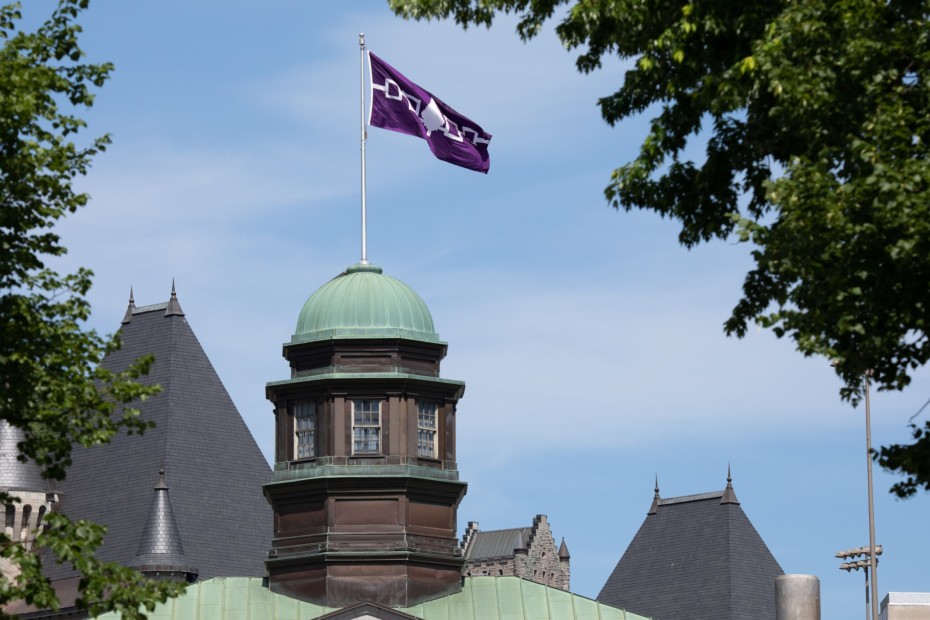
On June 18, Luciano Santavicca, Service Person C, Building Services, performed a task rarely done at McGill – he lowered the University’s iconic red-and-white flag flying from the cupola of the McCall MacBain Arts Building and he replaced it with another flag.
In its place, Santavicca raised the Hiawatha Wampum Belt flag, a centuries-old symbol marking unity and peace between the Seneca, Cayuga, Onondaga, Oneida and Mohawk nations.
The Hiawatha Wampum Belt flag flew from the Arts building until June 22, in honour of National Indigenous Peoples Day (June 21).
As with so many celebrations muted by COVID-19, the flag-raising was a modest affair, with only Santavicca and photographer Owen Egan being present. It was a far cry from the first flag-raising ceremony in 2018, which drew members of local Indigenous communities, Montrealers, and McGill students, staff, faculty and administration.
“[The 2018 ceremony] was a special day, more than I could’ve dreamed of,” remembers Kakwiranó:ron Cook, Special Advisor, Indigenous Initiatives, Office of the Provost & Vice-Principal (Academic). “It was the culmination of a long journey to get the flag on the Arts building.”
Provost’s Task Force on Indigenous Studies and Indigenous Education
Flying the Hiawatha Wampum Belt at McGill was one of the Calls to Action in the 2017 final report of the Provost’s Task Force on Indigenous Studies and Indigenous Education.
Provost Christopher Manfredi stuck the Task Force in 2016, in response to the 2015 report of the Truth and Reconciliation Commission of Canada. The mandate of the Provost’s Task Force is to engage and collaborate with McGill and Indigenous communities to identify, explore and advance ideas and initiatives that will enhance the presence and success of Indigenous students, staff and faculty.
For Cook, there is deep symbolism in having the flag of the Haudenosaunee, also known as the Iroquois Confederacy, flying from McGill’s most recognizable buildings on the traditional territory of the Kanien’kehà:ka, a place which has long served as a site of meeting and exchange amongst nations.
“It is very important to honour the land upon which McGill sits.” he says. “We need to raise awareness of Indigenous history and realities among Montrealers and people from across the world who are at McGill. The [Hiawatha Wampum Belt] flag is the physical representation of a powerful symbol – and its significance will only grow in time by inspiring ongoing and new dialogue. I think it’s a beacon of the University’s commitment to Indigenization.”
Symbol of peace and unity in polarized times
The symbolism of the Hiawatha Wampum Belt flag is even more profound, given that it was raised in a time of increased polarization and civil unrest, both in Canada and globally.
“The wampum belt is a symbol of peace and unity that brings together the five Iroquois nations,” says Cook. “We are distinct in our nations but united in this Confederacy, the Haudenosaune. Five arrows bundled together are stronger than one.
“We think of ourselves as a collective which is in such contrast to the individualistic society in which we live now. It’s not the Indigenous model native to this land.”
One step in a long journey toward reconciliation
But Cook is also a realist, and he understands that there are profound issues to be addressed at McGill and beyond in order to achieve true reconciliation.
“Truth and Reconciliation had its life for a period of six years and it had its report which is the driving spirit for the Provost’s Task Force. But we’re just at the start of all of this,” says Cook. “Institutionally, we are on a journey and it will take a long time. But I have faith that we will get there because I’ve met enough people at McGill to know we have allies who are committed to this journey.
“I feel like we’re on the way and we have momentum,” says Cook. “The flag raising is one of many expressions of reconciliation that we are cultivating at McGill.”
